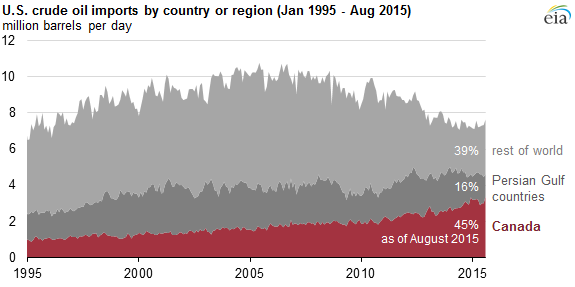New Government Data Undermines Obama’s Decision to Kill Keystone
The U.S. is increasingly importing crude oil from Canada, supplanting supplies we get from unstable countries and undermining reasons President Barack Obama used to justify killing the Keystone XL pipeline.
Energy Information Administration (EIA) data shows Canadian oil imports are increasingly replacing imports from the Middle East and other parts of the world where governments are unstable or hostile to U.S. interests.
“As of August, Canada provided 45 percent of all crude oil imports to the United States, almost three times as much as all Persian Gulf countries combined,” according to EIA. The energy statistics agency’s data shows how booming U.S. and Canadian oil production have increased trade between the energy giants and allowed Americans to use more North American fuel.
The facts plainly seem to contradict Obama’s claim that getting more Canadian oil wouldn’t increase America’s energy security.
“Shipping dirtier crude oil into our country would not increase America’s energy security,” Obama said in a speech rejecting the Keystone XL pipeline Friday. “What has increased America’s energy security is our strategy over the past several years to reduce our reliance on dirty fossil fuels from unstable parts of the world.”
Obama also argued the pipeline would “undercut” America’s image as a country “going green.” The president argued that while approving the pipeline wouldn’t be bad for the environment, the U.S. needs to “lead by example.”
As it turns out, Albertan oil sands — Obama’s “dirty fossil fuels” — are the main reason behind the rise in crude imports from Canada. Since virtually all of Canada’s oil exports are sent to the U.S., most of that production is coming into the country by rail — a much less efficient form of transportation than pipelines.
“While overall U.S. imports of crude oil are declining, Canada is one of the few countries from which U.S. crude oil imports are increasing,” according to EIA. “Over the past decade, U.S. imports of crude oil and other liquids from Canada have increased 58%. Nearly all of Canada’s crude oil exports to the United States come from the western provinces.”
This oil has primarily gone to petroleum refineries in the Midwest because there’s not enough pipeline capacity to bring it to the Gulf Coast — which is why the region is beginning to get more oil from Iraq.
Further, blocking Keystone doesn’t stop Canadian oil from coming into the country. It’s still coming, but by rail instead of pipelines. Shipping oil by rail results in much more carbon dioxide emissions than shipping crude through pipelines.
If it had been approved, Keystone XL would have brought 830,000 barrels of oil sands from Alberta to refineries on the Gulf Coast. But since the project was not approved, that oil must be moved by rail — a costlier and more emissions-intensive process.
A report by the right-leaning American Action Forum found that by delaying Keystone XL’s approval, Obama increased U.S. CO2 emissions by 7.4 million tons since 2012. Emissions from imported oil sands are likely to increase as more crude is shipped by rail. There are also increased risks of oil spills and deaths from rail accidents, according to AAF’s report.
“Replacing the capacity of the Keystone XL pipeline with rail transport risks additional oil spills and the release of up to 23,318 additional barrels of oil — nearly a million gallons of useful fuel entering the environment instead of the economy,” AAF found.
“The delay in building the Keystone XL pipeline risks up to 1,065 additional injuries and 159 additional fatalities,” AAF continued.
Oil sands coming into the U.S. by rail has decreased in 2015 due to low oil prices. Shipping crude by rail is more expensive than using pipelines.
Follow Michael on Facebook and Twitter
Copyright 2015 The Daily Caller News Foundation








